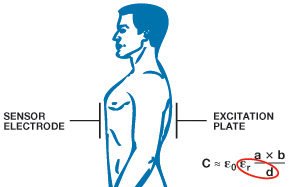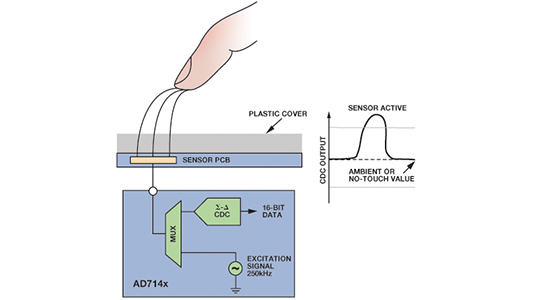Introduction
In recent years, advances in electronic technology have made many innovations and improvements in the healthcare industry possible. The challenges for healthcare equipment include developing new diagnosis and treatment methods, enabling remote monitoring and home healthcare devices, improving quality and reliability, and enhancing flexibility and ease of use.
For more than 40 years, Analog Devices’ comprehensive portfolio of linear, mixed-signal, MEMS, and digital signal-processing technologies have helped make a difference in healthcare designs in areas such as instrumentation, imaging, and patient monitoring. This article will focus on capacitance-to-digital converter (CDC) technology, which enables the use of high performance capacitance sensing in healthcare applications.
Capacitive Touch Sensor Controller—A Novel User Input Method
A capacitive touch sensor provides a user interface in the form of a push button, a slider bar, a scroll wheel, or other forms similar to the examples shown in Figure 1.

Each blue geometric area represents a sensor electrode on a printed circuit board (PCB) that forms one plate of a virtual capacitor. The other plate is formed by the user’s finger, which is essentially grounded with respect to the sensor input. The AD7147/AD7148 CapTouch™ controller family, designed to activate and interface with capacitive touch sensors, measures capacitance changes from single-electrode sensors. The device first outputs an excitation signal to charge the plate of the capacitor. When an object, such as the user’s finger, comes close to the sensor, the virtual capacitor is formed, with the user acting as the second capacitor plate (Figure 2). The capacitance is measured using a capacitance-to-digital converter (CDC).

The CDC, capable of sensing capacitance changes of the external sensors, uses this information to register a sensor activation. The AD7147 and AD7148, with 13 and eight capacitance sensor inputs, respectively, have on-chip calibration logic that compensates for measurement changes caused by changes in the ambient environment, thus ensuring that there are no false triggers on the external sensors due to changing temperature or humidity.
The AD7147 and AD7148 provide various operational modes, user-programmable conversion sequences, and very flexible control features. These features make them ideal for high-resolution touch sensor functions, such as slider bars or scroll wheels, with minimal software requirements. Furthermore, button-sensor applications can be implemented completely by on-chip digital logic without any software requirement.
Capacitance Detection and Measurement Basics
Capacitance is the ability of a capacitor to store energy in an electric field. In its nominal form—a parallel-plate capacitor—the capacitance, C, is a measure of the charge, Q, stored in a capacitor at a given voltage, V, and is calculated by

The essence of capacitance detection and measurement technique is shown in Figure 3 for a parallel-plate capacitor.

A parallel-plate capacitor consists of two conductors (metal plates) and is characterized by
- Conductor area, a × b
- Distance, d, between the two conductor plates
- Dielectric material between two conductors, characterized by the dielectric constant, εr
- The capacitance, based on this geometry, is calculated by

where ε0 is the permittivity of free space.
The CDC device applies an excitation to one plate of the capacitor and measures the charge stored in the capacitor; then, the digital result is available for the external host. Four types of capacitance sensors, shown in Figure 4, are differentiated by the way the excitation is applied.

Because the sensor capacitance is determined by a, b, d, and εr, varying the values of these parameters, or observing variations in their values, allows CDC technology to be used for direct capacitance value measurement, as well as for many other kinds of applications, depending on the sensor types. For example, if a, b, and εr are constant, the CDC output is in inverse proportion to the distance between two conductors.
Applications
The AD714x, AD715x, and AD774x families of CDC products are suitable for a wide range of applications, involving various sample rates, resolutions, input ranges, and input sensor types. Although the possible applications of capacitance sensing are limited only by the user’s creativity, here are a few ideas for applications in the healthcare field.
Liquid Level Monitoring
In many applications, such as transfusions, the amount of liquid used must be measured, or the flow must be shut down before the infusion bottle is empty. To save time for medical personnel, automatic liquid level sensing can help eliminate the need for manual checks.
The basic principle for liquid level sensing is shown in Figure 5. Build a parallel-plate capacitor with plates that tightly adhere to the outside wall of the infusion bottle and extend to near the bottom of the bottle. As the level of the infusion liquid changes, the amount of dielectric material between the plates changes, thus producing a change in capacitance. To allow the use of various infusion substances with different dielectric constants, a second capacitive sensor located near the bottom acts as a reference channel to produce ratiometric measurements.

The 24-bit AD7746, with its two capacitance measurement channels, could be useful for this kind of application.
Connectivity Detection Between Electrodes and Human Body
For devices intended to operate in the vicinity of human skin, such as those shown in Figure 6, it is often beneficial to have information about the quality of contact between the device’s surface area and the patient’s skin—before the device is activated or a measurement is taken. The range of end uses could include a medical probe that needs to rest flush on the skin, a biopotential electrode sensor, or the housing holding a catheter tube in place. To obtain this additional information, several capacitive sensor electrodes, shown in blue, could be embedded directly into a device’s plastic housing at the injection molding stage during manufacturing. Once the electrode information is available, a simple algorithm running on the host controller could be applied to determine if all sensor electrodes were making proper contact with the skin.

The examples shown in Figure 6 use capacitive sensors in an unconventional way: a user positions a device containing the capacitive sensing electrodes on the human body, in contrast with the traditional capacitive sensing human interface applications, where a person typically initiates contact with the sensor electrodes by finger touch. Developing the type of applications shown in Figure 6 is rather straightforward using the AD7147/AD7148.
Sweat Detection
In some medical and fitness-testing equipment, there is a need to measure perspiration from a human body. This is typically performed by measuring the skin’s electrical conductivity. However, if the measurement needs to be performed without galvanic contact, this function can be implemented by detecting the humidity near the human body using a capacitance sensor.
When people sweat, the humidity (dielectric constant) close to the human skin increases; a noncontacting electrode in this vicinity could be used to measure the resulting change in capacitance.
It may be useful to add a second capacitance sensor to measure the ambient humidity and use it for common-mode compensation.
Respiratory Rate Measurement
Respiratory rate measurement is an important module in patient monitoring systems.
In one approach, shown in Figure 7, an excitation plate is put on the back of the patient while the sensor electrode belt is fastened on the right side of the chest of the patient. As the lungs fill and empty, the resulting chest movements change the distance between two plates. The dielectric constant will also change because of the complex physiological activities during breathing. These capacitance changes can be measured by CDC devices.

The reason the sensor electrode is placed on the right side of the subject’s chest is that this position gets the least impact from other physiological activities. However, it might be possible to get more information on bodily functions by putting multiple sensor electrodes on different positions on the patient’s chest. This may be an interesting topic for further research.
Blood Pressure Measurement
In blood pressure measurement applications using an inflatable cuff, an important task is to measure the pressure at the air valve. A capacitive sensor can be easily used in this kind of pressure sensing applications.
As shown in Figure 8, the diaphragm of the pressure sensor is basically made from two capacitive plates. As pressure is applied to the sensor, the capacitive plates move closer together. The reduced distance between the plates increases the capacitance.
A temperature sensor can be used to detect the temperature change of the sensor to compensate its characteristics change with temperature. The AD774x family has an internal temperature sensor to measure the on-chip temperature—and an additional ADC voltage channel that can be used to measure the temperature at the sensor site.

Conclusion
This article, a brief introduction to advances in CDC technology at Analog Devices, hints at the enormous potential of CDC techniques in healthcare applications. However, sensor design—including pattern, size, and position—the associated detailed electronic circuit design, and the need for deep research, comprehensive experiments, and effective testing, are critically dependent on the nature of each application, so we merely hope to stimulate creativity by suggesting some possibilities here.
I invite you to comment on CDCs in heathcare in the Analog Dialogue Community on EngineerZone.
References
ADI CDC home page: http://www.analog.com/cdc.
ADI healthcare home page: http://healthcare.analog.com.
Prutchi, David, and Michael Norris. Design and Development of Medical Electronic Instrumentation. ISBN 0-471-67623-3. John Wiley & Sons, Inc., 2005. Information on all ADI products can be found at www.analog.com.
Author

Ning Jia is an applications engineer in the Customer Applications Center, Asia. He is responsible for technical support of a broad range of analog products across Asia. Ning joined Analog Devices in 2007 after graduating from Beijing University of Posts and Telecommunications with a master’s degree in signal and information processing.













